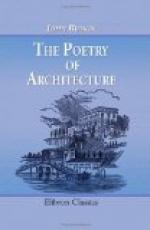[Footnote 24: Length is another thing: we might divide England into strips of country, running southwest and northeast, which would be composed of the same rock, and therefore would present the same character throughout the whole of their length. Almost all our great roads cut these transversely, and therefore seldom remain for ten miles together on the same beds.]
[Footnote 25: It is thus that we find the most perfect schools of architecture have arisen in districts whose character is unchanging. Looking to Egypt first, we find a climate inducing a perpetual state of heavy feverish excitement, fostered by great magnificence of natural phenomena, and increased by the general custom of exposing the head continually to the sun (Herodotus, bk. III. chap. 12); so that, as in a dreaming fever we imagine distorted creatures and countenances moving and living in the quiet objects of the chamber, the Egyptian endowed all existence with distorted animation; turned dogs into deities, and leeks into lightning-darters; then gradually invested the blank granite with sculptured mystery, designed in superstition, and adored in disease; and then such masses of architecture arose as, in delirium, we feel crushing down upon us with eternal weight, and see extending far into the blackness above; huge and shapeless columns of colossal life; immense and immeasurable avenues of mountain stone. This was a perfect—that is, a marked, enduring, and decided school of architecture, induced by an unchanging and peculiar character of climate. Then in the purer air, and among the more refined energies of Greece, architecture rose into a more studied beauty, equally perfect in its school, because fostered in a district not 50 miles square, and in its dependent isles and colonies, all of which were under the same air, and partook of the same features of landscape. In Rome, it became less perfect, because more imitative than indigenous, and corrupted by the traveling, and conquering, and stealing ambition of the Roman; yet still a school of architecture, because the whole of Italy presented the same peculiarities of scene. So with the Spanish and Moresco schools, and many others; passing over the Gothic, which, though we hope hereafter to show it to be no exception to the rule, involves too many complicated questions to be now brought forward as a proof of it.
[The comparison of Egyptian architecture with delirious visions seems to be an allusion to De Quincey’s passage in “The Pains of Opium”—the last paper in “the Confessions of an Opium-Eater”—where, after describing Piranesi’s Dreams, he tells how he fancied he was “buried for a thousand years, in stone coffins, with mummies and sphinxes, in narrow chambers at the heart of eternal pyramids,” etc.]]




